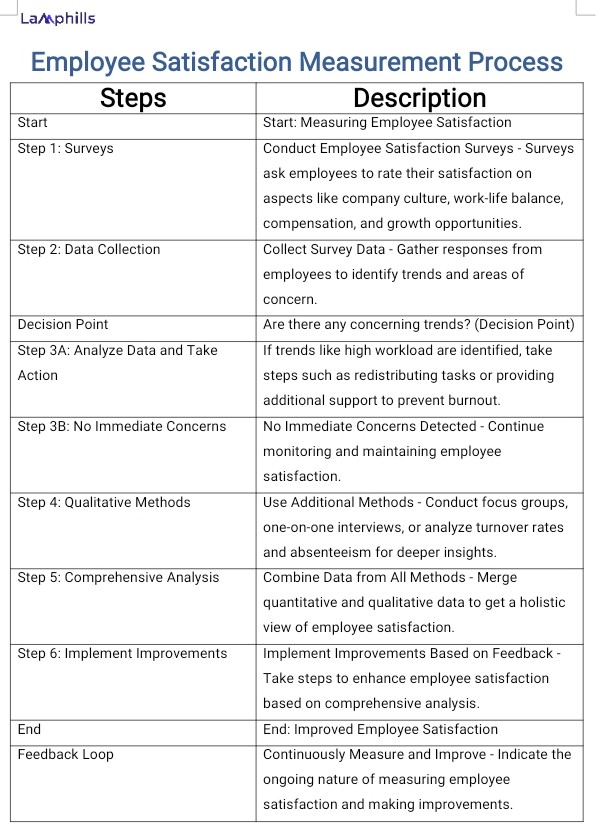As the old saying goes, “Happy employees are the heart of a successful business.” And in 2024, measuring employee satisfaction is more crucial than ever. Assuming you’re a business owner or HR manager looking for the best tools to gauge your employees’ happiness and engagement levels. That’s employee satisfaction measurement tools.
Well, you’re luck! In this digital age, there are many innovative tools at your disposal to make this task not only effective but also enjoyable. Let’s discuss employee satisfaction measurement tools and discover the top picks for 2024!
Key Points
- Employee satisfaction measurement tools are vital for enhancing workplace happiness and engagement, making them crucial for organizations in 2024.
- Culture Amp, TinyPulse, Qualtrics, Glint, and 15Five provide customizable surveys and insights, helping organizations gather and analyze employee feedback effectively.
- Measuring employee satisfaction regularly helps identify issues early, enabling prompt management intervention to maintain morale and productivity.
- Using these tools improves employee engagement, reduces turnover, boosts productivity, and fosters a positive company culture.
- Choose a tool that matches your organization’s needs, considering ease of use, customization, and ability to provide actionable insights.
Best Tools for Employee Satisfaction Measurement in 2024
This year, measuring employee satisfaction is crucial for any organization to ensure a positive work environment and high employee retention. There are various tools available that can help in effectively gauging employee satisfaction. Here are the best tools for employee satisfaction measurement:
#1. Culture Amp
Culture Amp is a popular tool that provides insightful employee feedback through surveys and performance reviews. It offers in-depth analytics and customizable surveys to understand employee sentiment better.
It’s this cool tool that lets you gather feedback from your team through surveys and performance reviews. But here’s the best part: it doesn’t just stop there. Culture Amp goes deep into the data and gives you all these fancy analytics to get a feel for how your employees are feeling.
And get this – you can customize the surveys to fit your company’s vibe. So, it’s not some cookie-cutter approach; it’s all focused to suit your unique needs. Also, it boosts employee satisfaction and makes your organization an even better place to work.
#2. TinyPulse
TinyPulse is popular for its easy-to-use platform that enables continuous feedback from employees. Employees can anonymously share their thoughts, which encourages honesty and transparency.
Imagine being able to share your thoughts, ideas, and concerns without revealing your identity – that’s the beauty of TinyPulse. It’s like having a virtual suggestion box that is open 24/7.
Let’s say you had a brilliant idea to improve workplace morale but were hesitant to speak up in a meeting. With TinyPulse, you can anonymously submit your suggestion and watch it gain traction without anyone knowing it was you. It’s empowering to know that your voice is being heard, even if it’s from behind the curtain.
Moreover, TinyPulse doesn’t stop at just collecting feedback. It goes the extra mile by offering pulse surveys and real-time feedback features. This means that your satisfaction as an employee is not just a one-time thing but a continuous process that is actively monitored. It’s like having your personal feedback tool that keeps you in about how you’re feeling at work.
#3. Qualtrics
Qualtrics is a versatile tool that not only measures employee satisfaction but also employee engagement and overall employee experience. See Qualtrics as your go-to tool for understanding how your employees feel about their work environment. It’s like a superpower that allows you to measure not just their satisfaction, but also their engagement and experience at the workplace.
With Qualtrics, you can create surveys that are tailored to your organization’s unique needs. These surveys can give you valuable insights into what makes your employees tick and help you identify areas where you can make positive changes.
The best part? Qualtrics doesn’t just end at collecting data. It also has powerful analytics tools that can get all that information for you. Plus, it uses AI-driven insights to give you a deeper understanding of what your employees are experiencing.
#4. Pulse Surveys
Pulse surveys are short, frequent surveys that can be sent out to employees regularly to capture real-time feedback. These surveys are great for quickly identifying trends and issues within the organization and can help management address concerns promptly.
For instance, sending out a short survey every couple of weeks to check in on how employees are feeling or what issues they might be facing. It’s a great tool for managers to quickly spot any trends or concerns within the company so they can address them promptly.
Plus, since pulse surveys are done more frequently than traditional surveys, they provide a real-time snapshot of employee sentiment. That’s helping management make informed decisions to improve the work environment.
#5. Glint
Among all the best tools for employee satisfaction measurement, Glint is a comprehensive tool that combines almost everything. Imagine having a tool that not only collects feedback from employees but also uses that feedback to help organizations improve employee satisfaction. Amazing, isn’t it? Well, it’s like having a personal assistant that makes sure your team is happy always.
With Glint, you can create surveys that fit your organization’s specific needs. These surveys give employees a voice to share their thoughts and feelings, which can be a powerful way to understand their experiences.
But Glint goes beyond just collecting feedback. It also uses people analytics to help you make sense of all that data. Real-time dashboards and heat maps visualize the feedback in a way that’s easy to understand. This means you can quickly identify areas that need attention and prioritize actions to address them.
So, if you want to increase your employee engagement strategies and foster a happier work environment, use Glint to help you listen, understand, and act on what truly matters to your workers.
#6. 15Five
Last but not least is 15Five, a tool that emphasizes continuous performance management and employee feedback. Among other tools for employee satisfaction measurement, I think 15Five has special features. Assuming you’re part of a team where sharing wins, overcoming challenges, and setting goals is as easy as sending a quick update. That’s where 15Five comes in, a virtual chat with your colleagues and managers every week.
Let’s say it’s Monday morning, and you log into 15Five to jot down your achievements from the past week. Maybe you finished a project deadline or helped a colleague solve a tricky issue. You can also mention any obstacles you faced, like struggling with a new task or feeling overwhelmed.
Now, the best part is that your manager gets alerted as soon as they notice your update. Lovely, huh? From there, they can offer praise, support, or even solutions to help you tackle those challenges.
With 15Five, communication flows freely between team members and managers. It’s not just about completing tasks; it’s about building a supportive and engaging work environment where everyone’s voice is heard and valued. Therefore, I must say that 15Five can turn your regular workweek into a collaborative and productive journey for all.
Also read these articles: How to Create and Use an Employee Benefits Tracking Spreadsheet: A Comprehensive Guide
Employee Branding in 2024: Top 9 Trends No Company Can Ignore (According to Experts)
What Is The Tool For Measuring Job Satisfaction?
When it comes to measuring job satisfaction, one tool that comes to mind is Culture Amp. I have personally used Culture Amp in my organization, and I must say, it has been quite effective in gauging employee satisfaction levels.
Culture Amp is a great tool because it provides a comprehensive insight into various aspects of job satisfaction. From engagement surveys to pulse checks, Culture Amp offers many features that allow us to delve deeper into what motivates and engages employees in the workplace.
One of the things I like about Culture Amp is its user-friendly interface. It is easy to set up surveys, gather feedback, and analyze the results. Also, the tool provides actionable insights and recommendations based on the data collected. That’s incredibly valuable for making informed decisions to improve employee satisfaction.
How Is Employee Satisfaction Measured?
Employee satisfaction is often measured using a combination of quantitative and qualitative methods. One common way to gauge employee satisfaction is through surveys that ask employees to rate their level of satisfaction with various aspects of their job. This includes company culture, work-life balance, compensation, and growth opportunities.
For example, XYZ company decides to conduct an employee satisfaction survey. The HR department creates a questionnaire asking employees to rate their satisfaction on a scale of 1 to 5 for different factors like workload, communication with managers, training opportunities, and job satisfaction.
After the survey is completed, the data is collected and analyzed to identify any trends or areas of concern. For instance, if a significant number of employees rate their workload as very high, XYZ Corp may need to look into ways to better distribute tasks or provide additional support to prevent burnout and improve satisfaction.
In addition to surveys, some companies use other methods to measure employee satisfaction. It can be conducting focus groups, one-on-one interviews, or analyzing turnover rates and absenteeism. By gathering data from multiple sources and actively seeking feedback from employees, you can understand what drives employee satisfaction and take steps to improve it.
See the table below for more information:

Also read this: Brand Measurement: Key Metrics and Methods for Evaluating Brand Performance
What Is Employee Satisfaction In KPI?
Employee satisfaction is a crucial Key Performance Indicator (KPI) for any organization. It measures how happy and content employees are with their jobs and workplace. For instance, when employees are satisfied, they are more likely to be motivated, engaged, and productive at work.
You might ask why employee satisfaction matters in KPIs. Well, happy employees tend to have higher job satisfaction. This can lead to lower turnover rates, increased loyalty to the company, and better performance. It’s like a domino effect – satisfied workers can positively impact the entire organization.
When you hear employee satisfaction in KPIs, it focuses on factors such as job security, work-life balance, career advancement opportunities, recognition for hard work, and a positive work environment. These factors can directly influence how satisfied employees feel in their roles. So, what are you waiting for? Explore the aforementioned employee satisfaction measurement tools to boost your productivity and the best working environment for you and your workers.
To help you choose the best employee satisfaction tool for your needs, here’s a practical checklist that covers key factors to consider.
Choosing the Perfect Employee Satisfaction Measurement Tool
Related Articles
A Step-by-Step Guide to Effective Competitive Benchmarking
The Importance of Branding in Financial Services (+ Examples)
HOW TO MEASURE BRAND REPUTATION IN 2024 (MY EXPERT TIPS)






